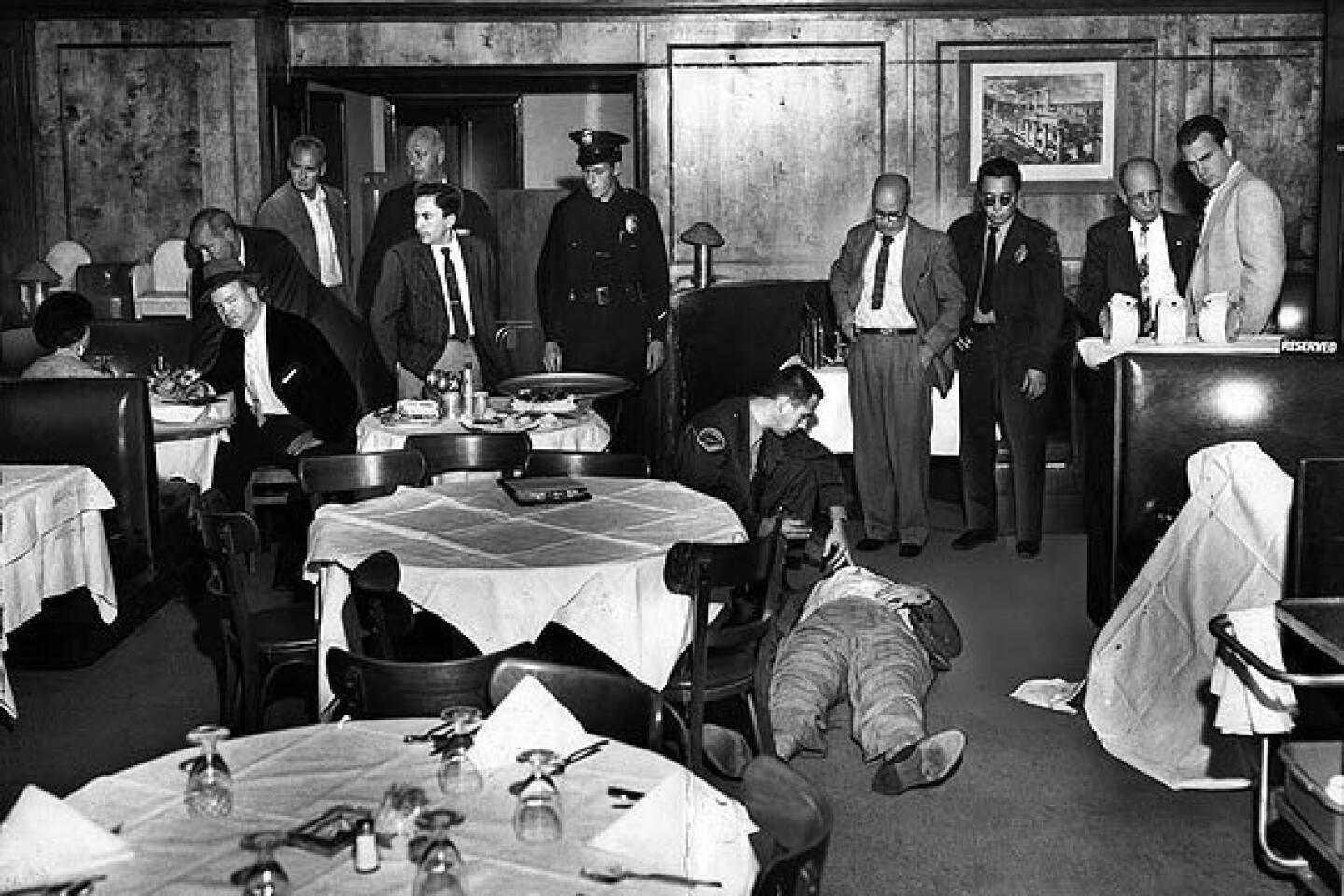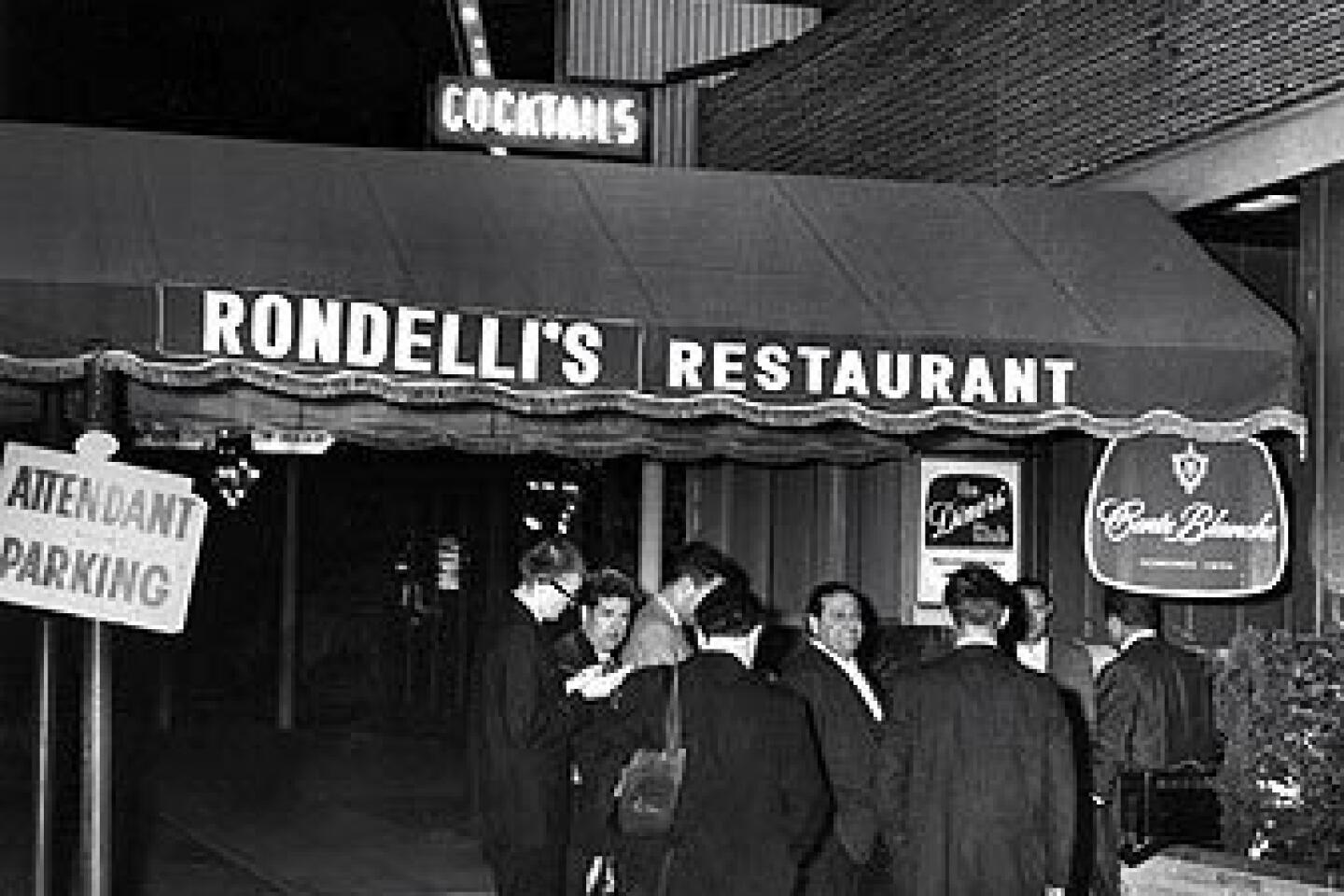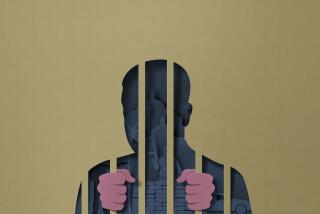A bullet between the eyes at Rondelli’s
- Share via
Jack Whalen’s beef was not directly with Mickey Cohen but with a couple of his crew, and it revolved around familiar issues in their realm: Who was scamming whom? And who would back down first?
The dispute had its roots in Nov. 21, 1959, vice raids on the homes of five phone clerks who took bets for Al Levitt, a Woodland Hills bookie. With Levitt’s records gone -- the cops had them -- a pair of bettors began clamoring for $390 they said they were due.
One of them was Sam Lo Cigno, who described himself as an unemployed bartender and asphalt salesman but managed to drive a new Cadillac. “I don’t believe anyone can win on horses,” Lo Cigno said, “but I was lucky.”
He had grown up in Cleveland while Mickey was there, and after Mickey moved west to serve as muscle for Bugsy Siegel, Lo Cigno came too. But with only one jail term on his sheet, five days for speeding, he seemed little more than “a flunky and errand boy for Mickey,” as a probation officer put it.
Now, the errand boy and his friend George Piscitelle were fixing to heist $390 from the just-raided Levitt until the bookie realized, no -- they’d lost their bets. On Dec. 2, he told them, “I am through with this. I am having J.O. call you,” and they understood exactly: J.O. meant Jack O’Hara, a.k.a. Jack “the Enforcer” Whalen.
In minutes, Piscitelle said, the phone rang in his apartment and it was the “head-buster,” declaring, “You Dago bastards” had better come up with what was owed.
Lo Cigno and his pals were getting ready for a night out, starting with supper at Rondelli’s on Ventura Boulevard. The pint-sized lounge singer Tony Reno was coming, and so was talent manager Joe DeCarlo, who handled Mickey’s two favorite strippers, Candy Barr and Beverly Hills.
Lo Cigno liked Rondelli’s because they served him pasta without the spicy sauce that inflamed his nervous stomach.
He wore one of his perfectly tailored suits, with a side pocket just the right size for his .38. “It hung in there real nice,” he said.
***
Tough as he was, Whalen wasn’t about to confront them alone. He’d called his pal on the Gangster Squad, but Sgt. Jerry Wooters had been busted to night duty at the police jail.
So Whalen had his frequent helpmate Rocky Lombardi meet him at a seafood joint on the Strip. “He wanted me to watch his back,” Lombardi said. Then they met a second backup, “Big Joe” Herrera, and headed to Sherman Oaks, those two in one car, the Enforcer in his own.
The backups got to Rondelli’s shortly before 11:30 p.m. and took positions at opposite ends of its dimly lighted bar. Customers filled all the stools and a row of cocktail tables.
Rocky barely had time to order a drink before Whalen burst through the swinging doors of the kitchen. He’d come in the back from an alley. Now he strode toward the phone booth. “I knew that he wasn’t there for pleasure,” said a woman at the bar.
You couldn’t see the dining area from the bar. They were separated by a planter filled with fake greenery rising nearly to the ceiling -- the sort of stuff that had been a staple of the nursery Mickey Cohen opened when he got out of prison.
***
Mickey had arrived between 8:30 and 9 p.m. in his new, black Caddy, accompanied by his bulldog, Mickey Jr. The dog had his own checkered bib so he could eat in style off a plate at his master’s feet.
At a hearing a month before on Rondelli’s application for a license to offer live entertainment, Mickey had taken the 5th when asked if he was a hidden owner. This night, he came early to meet with a black singing group seeking his help and with Roger Leonard, who fancied himself a writer-producer. Leonard was at Mickey’s table to talk about making “The Mickey Cohen Story.”
Sam Lo Cigno took the seat on Mickey’s left and Piscitelle took a seat on the other side, where he could see anyone entering the dining room. Last to arrive was Mickey’s date, Sandy Hagen, a model, full name Claretta Hashagen. She ordered the veal scallopini.
Mickey was constantly getting up, going to the office to make calls or the men’s room to wash his hands. Lo Cigno flitted about too, schmoozing with two women at the bar. He wanted Jo Wyatt and Ona Rae Rogers to join them later at the Cloisters, on the Strip, where Mickey had reserved a table to see comedian Joey Bishop.
The tiny crooner, Tony Reno, kept getting up also, to go to the pay phone, to find his manager, he said. That’s who he was trying to reach, he insisted, when an enormous hand lifted him out of the phone booth. He said Jack Whalen told him, “Show me where those bastards are.’ ”
Whalen prodded Reno into the dining area, but let him go when he saw who was there. Reno hurried back to the bar, where he couldn’t see what happened. He only heard the shots. After that, he looked across at Rocky Lombardi, the big man’s backup, and gave a hands-up gesture, like “What can you do?”
***
Mickey’s first story was that the shots came from a nearby booth and he “didn’t see nuthin’.” Then he changed that to, OK, they came from his table. But he still didn’t see much.
He said Whalen walked up and said, “Good evening, Mr. Cohen,” but he didn’t have time to respond because the Enforcer put his left hand on Piscitelle’s shoulder and said, “ ‘Have you got something for me?’ . . . and Bingo! . . . he hit George a shot” -- a powerful right -- “and George went to the floor.”
Whalen turned to Lo Cigno, Mickey said, and “he said, ‘You Dago bastard, you’re next’ or something of that sort. . . . The next thing, I heard the shooting, and that was it.”
“I never seen any gun,” Mickey said, describing how he ducked “from force of habit,” and stayed under the table, down there with the dog, Mickey Jr., and when he finally looked up, the restaurant was empty.
That became Mickey Cohen’s story.
Only the women from the bar had not left. Jo Wyatt and Ona Rae Rogers sometimes waitressed on the Strip and knew who Whalen was.
Wyatt hurried to the dining area and found him lying on his right side, next to the pastry table. Whalen was still breathing, but bleeding from his head, so she got napkins and towels and asked her friend to get ice. To one fleeing diner, it looked like she was kneeling in prayer over the body.
Wyatt said she pleaded, “Please call a doctor,” and Mickey did -- he phoned his own physician. “Next thing,” Mickey said, “I went and washed my hands.”
***
Whalen was dead when police arrived at 12:10 a.m. The first bullet had missed. The second got him almost between the eyes.
Chief William H. Parker and Capt. James Hamilton, head of the Gangster Squad, were there within an hour. But the honor of questioning Mickey fell to Thad Brown, the cigar-chomping deputy chief who was familiar with the victim. “He’d been flirting with the undertaker for a long time,” Brown said of Whalen.
“So help me God, chief, I didn’t shoot him,” Mickey said.
“Who did?”
“I don’t know.”
When the press arrived, Parker revealed that Hamilton’s squad had been tipped earlier that Whalen might be going to Rondelli’s “to settle a beef.” Parker did not say where the tip came from.
***
Jerry Wooters was awakened by the phone at 2 a.m. It was Hamilton, and it was not a friendly call.
“He says, ‘Where can we pick up’ -- see, now suddenly he knows I’m close to Whalen. He says, ‘Where can I pick up Mrs. -- Whalen’s wife?’ I said, ‘Captain, you’re talking to a uniformed sergeant. . . . You got all those high-powered detectives down there. Let them find out.’ So he says, ‘Listen . . . you think you’re so smart. And Jesus, he went on with stuff I never heard about. And I said, ‘Listen, I assume you’re recording this. And I have no desire to talk any further. I’m on overtime if you pull me down.’
“ ‘God damn it, blah, blah, blah.’
“So I didn’t tell him anything.”
Only later did Wooters learn that an unmarked Intelligence car had gone to Rondelli’s as a result of his tip the night before. But the two squad members simply parked on Ventura Boulevard. They never went in. They hadn’t realized anything was amiss until the other police cars pulled up.
So that’s what his years as the secret buddy of Jack Whalen had come to -- him stuck in the jail, Whalen dead on the floor and two cops “sitting outside that goddamned place when the shots were fired.”
***
When the sun came up in the morning, one of the swarm of officers still at the scene searched through a trash can next door and discovered a plastic bag with three .38s in it.
That was the moment another member of the Gangster Squad had been anticipating for a decade.
Jack O’Mara got to Rondelli’s while the body still lay there. When he heard what was in the trash, he told Hamilton, “Cap’, they could be the guns I took.”
Hamilton remembered well how O’Mara had sneaked seven guns out of Mickey’s house ages ago and etched initials under their butt plates in hopes of one day proving the man was a killer. The Gangster Squad had been trying to make that case, but failing, since 1946.
On Dec. 8, 1959, six days after the shooting, Lo Cigno came out of hiding to surrender at LAPD headquarters, saying he was turning himself in at Mickey’s urging.
LoCigno announced: “Well, I’m the man that shot Jack O’Hara in self-defense.”
Times researcher Maloy Moore and former researcher Tracy Thomas contributed to this series.
More to Read
Sign up for Essential California
The most important California stories and recommendations in your inbox every morning.
You may occasionally receive promotional content from the Los Angeles Times.












